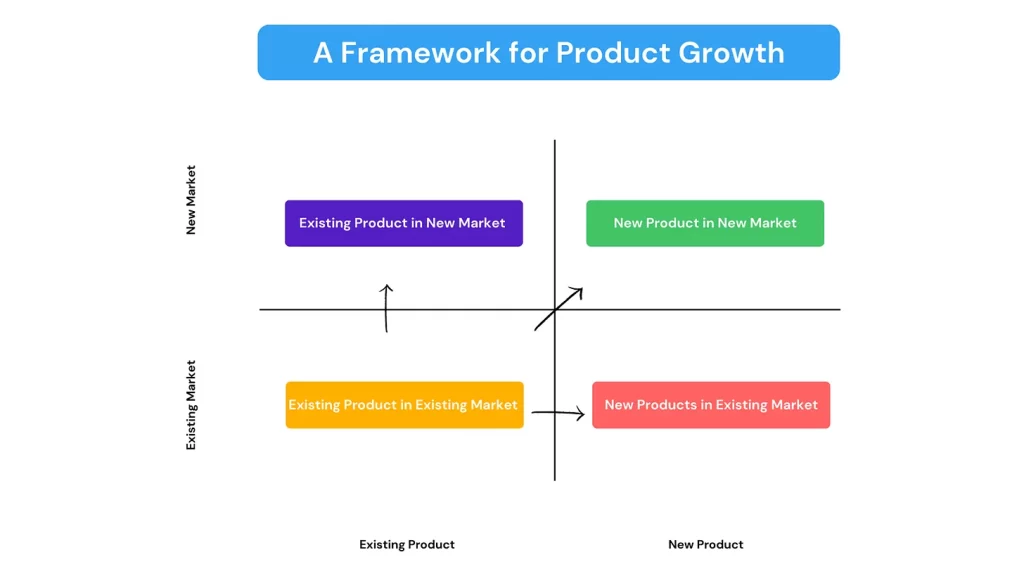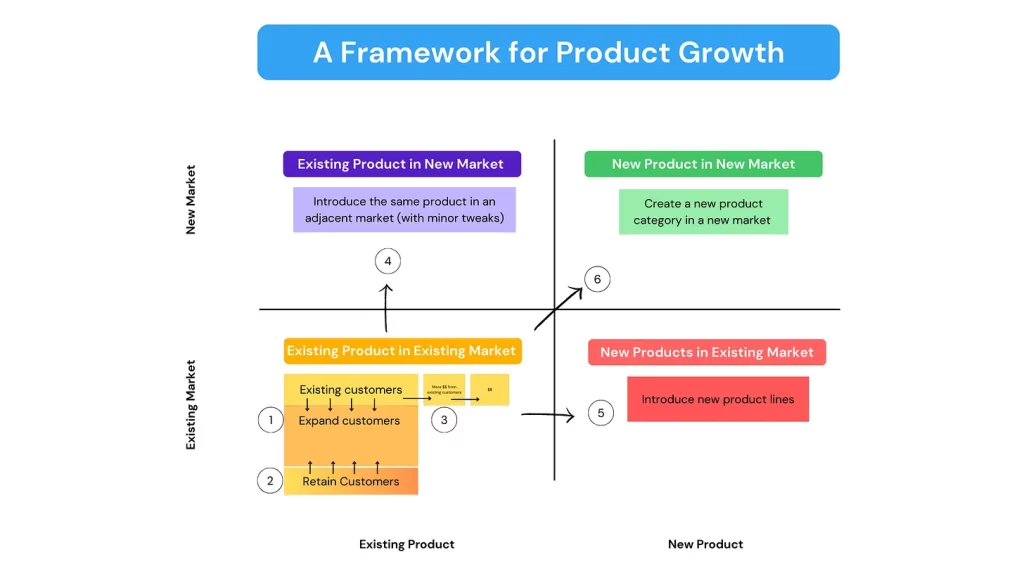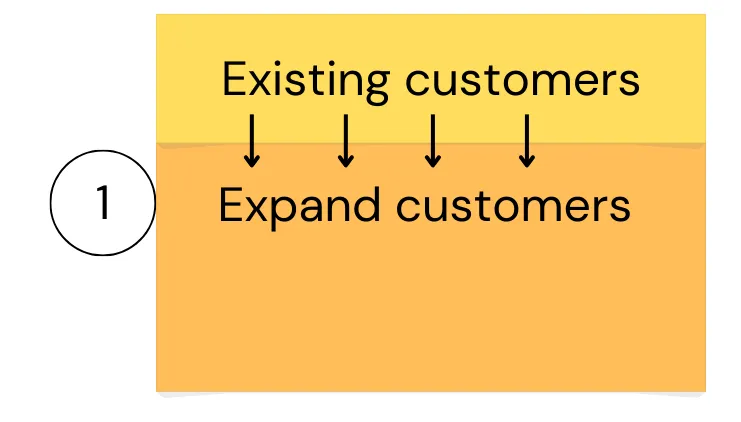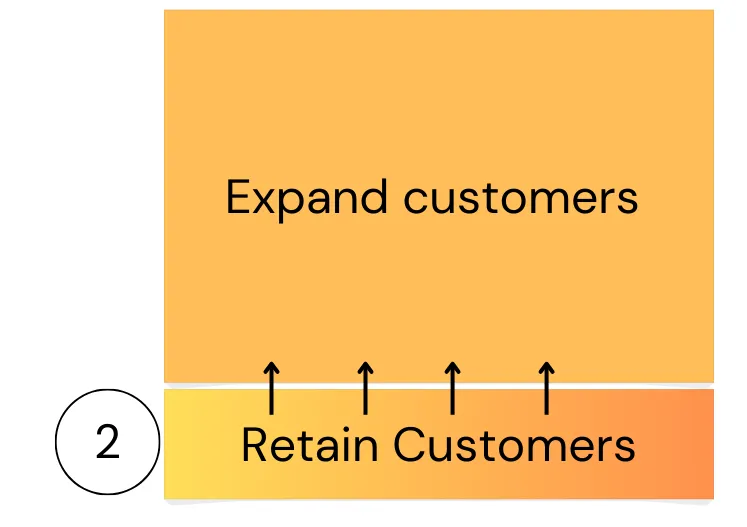A framework for identifying growth opportunities
As a Product Manager, your main goal is to grow the business. Your product is your medium through which you grow the business. While there are roles specifically targeted towards growth, my firm belief is that every product manager needs to have growth as their core job.
Now there are various definitions of growth. A simplified way to look at growth is increased revenue and/or lowered costs. For the purposes of this essay, we will focus on growth in terms of growing revenue.
Growth comes from a variety of sources. Which one is relevant to you depends on the market your company is in, the stage of your company and the relative position of your company in the market.
As a product manager, how do you think about the growth of your product and your business. After all, a product managers main goal is to build something that customers need. That’s a simplified 100K ft level view.
In this graphic, you will see 4 quadrants (Ansoff Matrix). Let’s say you are a PM for an existing product. How will you think about growing revenue.

You can grow in your existing market, create a new product or move to an adjacent market.
Let’s drill down to 50K ft level and understand the levers that are at your disposal. Later we will discuss which direction to go into.

1. Expand to similar customers

Your product is already used by 100s or 1000s of customers. In order to grow, your sales and marketing team need to find similar customers.
The primary objective as a PM is to keep the product running smoothly, continually improve experience and add incremental features.
Keep track of feature requests and prioritize relentlessly. Focus on those enhancements that will help a large segment of existing or new customers. Prioritization is a topic unto itself with 100s of frameworks, so I’ll just keep it at this high level for this article. Prioritize based on the maximum outcome.
As more customers are added, you will realize there are still a few friction points that prevents customers from getting onboarded quickly. Identify them and optimize to streamline the new customer experience. As a PM, you should be able to understand deeply this segment of your customers, the personas, the use cases and the friction points that your product is going to solve. Your job as a PM is to make sure that new customers are getting onboarded and getting to the value point quickly.
When you start expanding your customer base, you will also find a lot of competition. As a PM, you need to ensure your value proposition is better than the competition. It could be a better feature set, or better experience. Your goal is to find a way to prevent your next best competitor to steal your business.
The common adage is to focus on customers and not on competition. That’s true. But your competitors are doing the same – focussing on their customers. So if their messaging or positioning is better, you will lose. So rather than copying your competition’s features, find the messaging they are using to get customers, and beat that. Marketing and communications plays an important role but it is the PM who needs to keep tabs on the what.
2. Retain existing customers

In a SAAS business, retention is the life blood of growth. Ask ChatGPT why retention is important and you will find the business reason. It’s cheaper to retain an existing customer, than to find a new customer. Think of a leaky bucket, the bigger the hole, the more water you need to pour in. If you are adding new customers at say 20% but losing 20%, then your growth is 0. Increase retention by 10 points, and your growth is 10%, without increasing the growth rate i.e. with the same set of sales team.
And if you do the math, then keeping the same revenue level is more expensive when retention is lower. While revenue growth is important, profitability is even more important. You can grow customers but they will come at 3x-4x the cost than to retain an existing one. So retention is extremely important.
While this is all sales and finance mumbo jumbo, I advise all PM to learn about retention and track these metrics religiously. Specifically, understand where customers are churning and why. Is it due to a specific feature not working, then fix it. Is it a certain segment of customers who is churning more, then find out the root causes.
And while you are at it, build the next product or features with stickiness in mind. A sticky product goes a long way to improve retention. There are many ways to make your product sticky, and will be discussed in a future article.
3. Cross and Upsell to existing customers

Both cross-selling and upselling are techniques used by businesses to increase revenue from existing customers. However, there is a difference between the two.
Upselling refers to the practice of offering a more expensive or upgraded version of a product or service to an existing customer. For example, a SaaS company may offer a more advanced version of their software to an existing customer who is currently using the basic version or a free version. When you upgrade a free version of Zoom or Calendly or Notion to a paid version, that’s an example of upsell. Let’s use another example in CPQ – say your product provides a way to create quotes that your customers can send to their customers, but they cannot customize it. You could upgrade them to a tier that allows for customization. As a PM, you need to understand the importance of that customization and the value it provides to customers.
You can also upsell by adding more usage from customers.
For example, your current product is currently only used by sales people. By adding some executive dashboards and workflow, you can expand the capability to the executive team. Or, let’s say your sales team uses Calendly for scheduling, can HR teams also use for recruiting purposes? Or support team to schedule meetings with customers? You added more users for exactly the same product. The only thing that might change is the messaging and positioning.
Cross-selling refers to the practice of offering complementary or related products or services to an existing customer. The goal is to encourage the customer to purchase additional products or services that are related to their initial purchase. For example, a SaaS company that provides a project management tool may cross-sell a time-tracking tool or a collaboration tool to an existing customer who is already using their project management tool. Another example, you have a web app for sales management that your sales people use. You could add a mobile app or an Outlook add on for extra cost that allows users to use the system on the go.
As a PM, you need to think about opportunities of how your product can be upsold or cross sold by taking a critical look at the personas and their jobs to be done. Having an understanding of the customers and all their use cases is important so that you can adjust your product accordingly.
4. Same product into a new market
You already have a product that is being sold in an existing market. Now your goal is to find new markets for the same product.
For example, your product is well established in the US. Now you can find opportunities in say EU and find similar customers. Can the same product work? Most likely you will need to add some tweaks e.g language, GDPR.
Another example, you have a product that checks for employment verifications that HR teams uses. Can we expand that to vendor verifications that a purchase department can use? Or maybe you can offer the same to property managers who are verifying renters on behalf of landlords? These are examples of going into a new market. The product could work as is or may require tweaks. How you position the value proposition and understanding the persona and the use cases are completely different in a new market.
As a PM, you have to evaluate what new markets can your product be used and which one has the biggest impact.
5. New product same market
You already serve an existing market. And the market is big enough with many adjacent needs that you can help provide products for.
Service now has a flagship product for IT help desk. Then they added a service desk to help customer support teams. They could just leverage the relationships with existing customers and sell this new product.
This strategy works well when your product and the adjacent products are well integrated and the whole value is greater than the sum of the values. Salesforce and SugarCRM are vendors in the sales management CRM space. Later they added marketing and customer service solutions, all integrated in one suite. Now they can offer a customer 360 view which has far more value to the customer than point solutions.
6. New product in new market
This is by far the hardest motion to execute and not that frequently practiced. And in most cases, these are acquisitions made by companies to get into a new market quickly with a new product.
It’s hard because you are entering a new market where you lack brand recognition, customers needs are different and competitors are different.
There are some good examples.
Hootsuite is a B2B SaaS company that provides social media management tools. In 2020, it entered the employee advocacy space with the launch of Hootsuite Amplify, a platform designed to help companies amplify their brand through employee advocacy. By expanding its product offering to include employee advocacy tools, Hootsuite was able to enter a new market and offer a unique value proposition to its customers.
Stripe is a B2B SaaS company that offers payment processing and other financial services to businesses. In 2019, it entered the corporate credit card space with the launch of Stripe Corporate Card, which offers a range of features designed to help businesses manage their expenses more efficiently. By expanding its product offering to include a corporate credit card, Stripe was able to enter a new market and offer more value to its customers.
While expanding to new products in a new market sounds exciting, be wary of the execution challenges.
How to decide which path to pick?

You are probably wondering, that’s a lot of choices. Which route should our product team take. The answer to that question is a bit nuanced.
Let’s say you are a PM in an existing market. Your choices are –
- Expand to similar customers
- Cross/Upsell to current customers
- Find a new market
- Create new products
Let’s assume retention is already part of your product motion and given.
So which is is it?
There is no perfect answer. The route you take depends on a number of factors. Let’s try some scenarios.
If the market you are in is large, and your company is #3 or 4 then you have room to grow and expand to similar customers. Maybe you can expand globally or find a slightly different set of customers than your traditional customer base. For example, if you are a PM in CRM or ERP, then you have a lot of room to grow and replace your competitors because these are huge markets. You need to fully understand what core needs you are already solving and what needs remain to be solved for customers you already have. Most of the time you will be enhancing the current product that keep adding value to your customers. The more value you add, the more satisfied your customers are, the more you have leverage to expand to other similar customers.
What if your market is not large or perhaps you are already well established, then you could find an adjacent product. Docusign is well entrenched in the eSignature space. While they have room to grow in that market, there is competition and they face limits to their growth. So they had to find an adjacent product. They now sell Contract lifecycle management solutions. Similar customers, but a different offering. Introducing a new product will work if your existing customers have a pain point that needs addressing and a product from you is more desirable for them as it would be part of an integrated suite. You are dipping into a different budget item from the customer and you need to come up with a whole new value proposition to sell.
What if your customers are large enterprises. They tend to have a large number of requirements ranging from reporting, security, compliance etc. Perhaps you can add more features into your product and offer them additional value add. For example, you may already provide some reporting capabilities, but you could add an advanced reporting module for enterprises who need more detailed reporting. And they would be willing to pay more for these capabilities. There are many opportunities to add upsell opportunities into your existing customers.
Another aspect you can think about is to increase usage within existing customers. Let’s say your product is aimed at a specific persona e.g. Digital marketers. Could you add more capabilities that expand the user base to say content creators or the say the sales team. By adding some features you can increase the number of seats a customer can buy. If your product is priced by say number of APIs, you could open up more use cases for your customers. You may need more APIs to build perhaps, but you will increase your revenue base just in your existing customer base.
To summarize, there are many ways to think about growth.
Revenue growth does not just mean adding new customers. Growth can come from a variety of sources. Understand the state of your business, your market, your product and map your product strategy with the business strategy. It is critical to be thoughtful about your revenue growth strategy as product manager.
Final note
Now, a few of you might wonder, why should product managers be responsible for growth. Isn’t that a sales and marketing job? We build products that they can sell and grow our revenues.
Yes, technically you are correct. Someone has to do the selling whether online or offline. But that’s just the mechanics of how the product gets into the hands of customers.
But think about what they are marketing or selling. They are selling the value that you as a product manager has chosen to provide to your target customers. So it’s in your hand what value has to be provided to your customers and how it has to be communicated and eventually sold. How well marketing or sales is able to sell your product is a function of how well conceived is the perceived value of your product.
As a product manager, you are responsible for growth.

